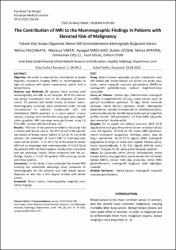The contribution of MRI to the mammographic findings in patients with elevated risk of malignancy

View/
Access
info:eu-repo/semantics/openAccessDate
2014-05Author
Yalçınkaya, MelisaVarer, Makbule
Sarsılmaz, Ayşegül
Sezgin, Gülten
Apaydın, Melda
Ozelci, Ummuhan
Gelal, Fazıl
Oyar, Orhan
Metadata
Show full item recordAbstract
Objective: We aimed to examine the contribution of breast
magnetic resonance imaging (MRI) to mammography in
high-risk patients with partial mastectomy, and/or with a
family history.
Material and Methods: 80 patients were scanned with
mammography and MRI at our hospital. 30 of the patients
had partial mastectomy due to the diagnosis of breast
cancer. 52 patients had family history of breast cancer.
Mammography scannings were performed under normal
circumstances in standard craniocaudal (CC) and
mediolateral (MLO) positions or in some special circumstances,
scanings were performed using spot and magnification
graphies. MRI scannings were performed using 1.5
Tesla MRI scanner with dual breast coil.
Results: Fifty two of the patients enrolled in this study had
a relative with breast cancer. 30 (37,5 %) out of 80 patients
had history of breast cancer before. In 12 (15 %) out of 80
patients, the advantage of breast MRI to mammography
could not be proven. In 54 (67,5 %) of the patients breast
MRI had an advantage over mammography. In 5 (6,5 %) of
the patients MRI had false negative results when compared
with the pathology results. When compared with the pathology
results in 9 (19 %) patients MRI scanning results
were false positive.
Conclusion: In this study, it was concluded that breast MRI
scanning has reasonable advantage when compared to
mammography for the patients who had breast cancer
diagnosis or who has a first degree relative with breast
cancer. Amaç: Meme kanseri nedeniyle parsiyel mastektomi veya
aile öyküsü gibi, meme kanseri için yüksek risk grubu olgularda,
meme manyetik rezonans görüntüleme (MRG)’nin
mamografik görüntülemeye katkısını değerlendirmeyi
amaçladık.
Gereç ve Yöntem: Seksen olgu, bölümümüzde mamografi
ve MRG ile değerlendirildi. 30 olgu, meme kanseri tanısı ile
parsiyel mastektomi geçirmişti. 52 olgu, birinci derecede
akrabada meme kanseri öyküsüne sahipti. Mamografik
görüntüleme, standart kraniokaudal ve mediolateral pozisyonlarda
elde olundu. Gerekli durumlarda spot ve magnifiye
grafiler eklendi. MR görüntüleri, 1,5 Tesla MRG cihazında,
dual meme koili ile elde edildi.
Bulgular: Elli iki olguda aile öyküsü mevcuttu. 30(% 37,5)
olguda daha önce geçirilmiş meme kanseri ve tedavi öyküsü
vardı. 80 olgudan, 12'sinde (% 15), meme MRG görüntülemenin
mamografi bulgularına herhangi katkısı veya ek
bulgu saptanmadı. 54 (% 67,5) olguda, MRG, mamografi
bulgularına ek bulgu ve tanıya katkı sağladı. Patoloji sonuç-
larıyla kıyaslandığında, 5 (% 6,5) olguda MRG'de yanlış
negatif, 9 olguda (% 19) yanlış pozitif bulgular saptandı.
Sonuç: Bu çalışmada, birinci derece akrabalarında meme
kanseri öyküsü veya geçirilmiş meme kanseri tanı ve tedavi
öyküsü bilinen, yüksek riskli olgu grubunda, meme MRG
görüntülemenin, mamografik bulgulara katkı sağladığını
saptadık
Source
Afyon Kocatepe Üniversitesi, Kocatepe Tıp DergisiVolume
15Issue
2Collections
- Kocatepe Tıp Dergisi [154]


















